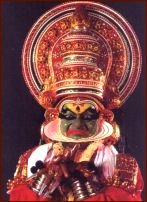Kathakali - Origin & Background
From "A Dancer on Dance" written by V.P. Dhananjayan, published by Bharata Kalanjali
Origin
of Kathakali
Sometime in
the 17th century A.D., one of the Zamorin Rajas of Calicut composed a lyrical
poem meant for a dance called Krishna Natakam. It came to be enacted
in the great Krishna Temple of Guruvayur, then under the control of the
kings of Calicut, under the name of "Krishnattam". A contemporary
of his, further South, belonging to the Royal family of Kattarakara, required
this play to be enacted in his palace but the Zamorin refused to oblige
him. Tradition has it that the prince of Kottarakara composed several
plays on the theme of the Epic Ramayana, calling them "Ramanattam", which
were staged as a challenge to the Zamorin of Calicut.

Later another
great royal composer, the Raja of Kottayam, composed several other beautiful
dance-dramas taking the themes from the epic Mahabaratha. Since these
were on Sri Krishna, the name was no longer applicable and the general
title "Kathakali" meaning dance drama evolved. Since the time of
these two royal composers, several other beautiful plays have been written
by other kings, chieftans and members of the great noble families who could
afford to maintain Kathakali troupes of their own.
Out of the
temple
As in all
classical plays of Kerala, Kathakali had its origin in temples. Even
now 'Kodiyattam' and 'Krishnattam' are not performed outside temples, but
'Kathakali' while it continued and still continues to be performed in temples,
is also performed outside. Its great popularity is due to the fact
that it is not confined to the precincts of the temples. Kathakali
can be staged anywhere - in a rural setting, under a tree, in the courtyard
of a house, or in any place convenient to the public - wherever a
number of people can sit and watch the play enacted. A raised platform
is not necessary. The actors, the singers and the drummers require
only a minimum of 100sq. feet of flat space on a level ground. A
temporary thatched roofing over this so called stage is also prepared.
The state
of affairs
In the earlier
part of this century there was a sudden cultural awakening throughout India
with the momentum given by the freedom movement. Of course it was
Rabindranath Tagore who really sowed the seed for cultural renaissance.
Smt. Rukmini Devi revived the art of 'Sadir or Dasiatam' now known
as Bharatanatyam, Poet Vallathol Narayana Menon revived the art of Kathakali
with the establishment of his Kerala Kalamandalam - (the school for Kathakali)
- and Kathakali regained its lost prestige and a lot of development took
place. Now there are several academies for teaching Kathakali in
and outside Kerala. As in the case of other art forms the patronage
also shifted from temple to clubs and cultural organisations. It
must be noted that considerable improvement has been achieved in the presentation
of the dance drama, Kathakali. Since technically and theoretically
Kathakali has its roots in Natyasastra traditions, certain innovations
and modifications were not successful and they did not fit in well to match
the loftiness of this unique dance style. But the music for Kathakali
has tremendously improved and now it almost follows the Karnatic style
of singing leaving behind its original folk character.
The Drama
& its Historical Background
Kathakali
is an indegenous, classical dance-drama from Kerala in the south west of
India. Kerala, situated as it is on the coast of the Arabian sea,
claims ancient contact with countries like Egypt, Syria, Rome and Greece
and to certain extent, these contacts are reflected in the art, literature
and society of that area. It is said that even Kathakali shows traces
of the influence of other countries. Kathakali is made up
of two words. 'Katha' in Sanskrit means story and 'Kali' a Dravidian
word meaning play. The very name is indicative of its Aryan-Dravidian
character.
Early Influences
The earliest
to be noted in this form is the ritualistic influence. In Kerala,
the earliest form of dance are connected with the rituals of the temples
(known by the names of Kaliyattam, Tirayattam and Theyyam). The origin
of the costume worn by the Kathakali dancers is to be traced to these time-old
ritual dances. Though the crowns and other ornaments and costumes
worn by Kathakali actors are highly sophisticated and artistic, the prototypes
were comparatively crude, although, in their own way, very ornamental.
Another influence
which can be traced is the martial art. The Nayars of Kerala were
warriors by profession and were trained in a very rigorous system of martial
exercises which are still used in the training of Kathakali. To these,
the overwhelming influence of the tradition of presentation of Sanskrit
plays was added and a new art form came into being, called Koodiyattam.
Gesture and facial expression formed the main vehicles of this acting technique.
For all purposes, Koodiyattam may be taken to be as the ancestor of Kathakali.